RSN Crewelwork Course: project design
The objective of the RSN Certificate Course in Crewel work is to design and work a crewel work embroidery that includes traditional elements of design, showing an understanding of color and using a wide variety of stitches. These are the elements on which I will be assessed and, like all students, I want to do my very best.How to begin? By studying as many photographs and patterns of crewel work as I can find. The internet is helpful but the real gold mine has been the old books in my library.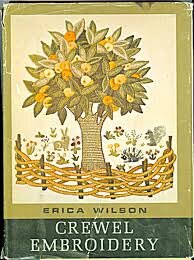
 There are two in particular that have been so helpful: Crewel Embroidery by Erica Wilson and The Art of Crewel Embroidery by Mildred J. Davis. Both of these books belonged to a member of my family and I treasure them all the more because of that. Each book is the perfect combination of history, photos of completed crewel work, stitches and ideas for original designs.In The Art of Crewel Embroidery, Mildred Davis has a large section of the book devoted to "Design Elements". There are individual leaves, flowers, fruits and even animals all drawn in black and white. Inside each element she has noted which stitches one could use and even the direction of the shading stitches. The much newer and equally good book (but quite different in style and presentation) Crewel Embroidery: a Practical Guide by Shelagh Amor has a similar section. Amor has compiled pages of simple leaf, flower and animal shapes for us to use when designing our own crewel work embroidery. In addition, she includes very clear instructions about how to draw a tree of life design and how to build up beautiful S curves based on groups of circles. Both of these books were helpful to me as I worked to draw my own design.
There are two in particular that have been so helpful: Crewel Embroidery by Erica Wilson and The Art of Crewel Embroidery by Mildred J. Davis. Both of these books belonged to a member of my family and I treasure them all the more because of that. Each book is the perfect combination of history, photos of completed crewel work, stitches and ideas for original designs.In The Art of Crewel Embroidery, Mildred Davis has a large section of the book devoted to "Design Elements". There are individual leaves, flowers, fruits and even animals all drawn in black and white. Inside each element she has noted which stitches one could use and even the direction of the shading stitches. The much newer and equally good book (but quite different in style and presentation) Crewel Embroidery: a Practical Guide by Shelagh Amor has a similar section. Amor has compiled pages of simple leaf, flower and animal shapes for us to use when designing our own crewel work embroidery. In addition, she includes very clear instructions about how to draw a tree of life design and how to build up beautiful S curves based on groups of circles. Both of these books were helpful to me as I worked to draw my own design.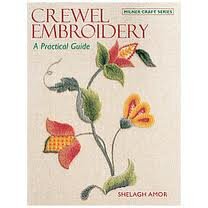
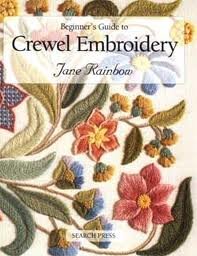 For a visual feast, providing inspiration, I devoured The Beginners Guide to Crewel Embroidery by Jane Nichols, Crewel Embroidery by Joan Edwards and Art of Embroidery by Lanto Synge. Most of the work in these books is too complex to be finished successfully in the 8 days we have on the course but the ideas were invaluable.
For a visual feast, providing inspiration, I devoured The Beginners Guide to Crewel Embroidery by Jane Nichols, Crewel Embroidery by Joan Edwards and Art of Embroidery by Lanto Synge. Most of the work in these books is too complex to be finished successfully in the 8 days we have on the course but the ideas were invaluable.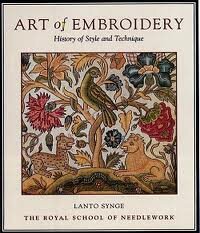
The advice given to us in our introductory information includes:
...Jacobean designs include a tree of life with entwining foliage and flowers and an insect or bird or animal.
...tutor will have source material for you to look at and
...will make suggestions and help you bring your ideas together
...be flexible in your approach, listen to your tutor’s experienced advice
...better to keep the design small and simple, with scope to include a variety of stitches,
The RSN has given us guidance but not restrictions other than size: the piece cannot be larger than A4 (a little larger than 8 1/2 x 11 inches for my North American readers).
Here is my first attempt at a design that follows their suggestion of using a tree of life with animals. I'm pleased with it but I'm not sure it's the one I'll choose to stitch in the end.
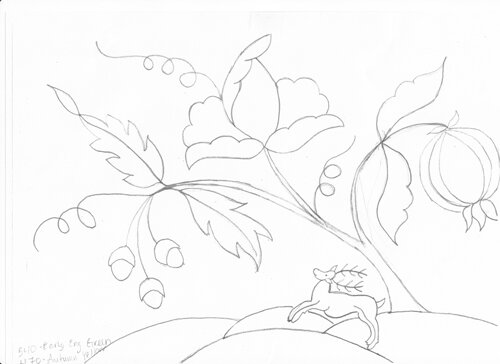 Here's a design from William Morris - the outline shape of one of his designs. I will break up the large sections into smaller ones for the variety of stitches we are to use if I decide to go with one large, more simple shape rather than a tree of life design.
Here's a design from William Morris - the outline shape of one of his designs. I will break up the large sections into smaller ones for the variety of stitches we are to use if I decide to go with one large, more simple shape rather than a tree of life design.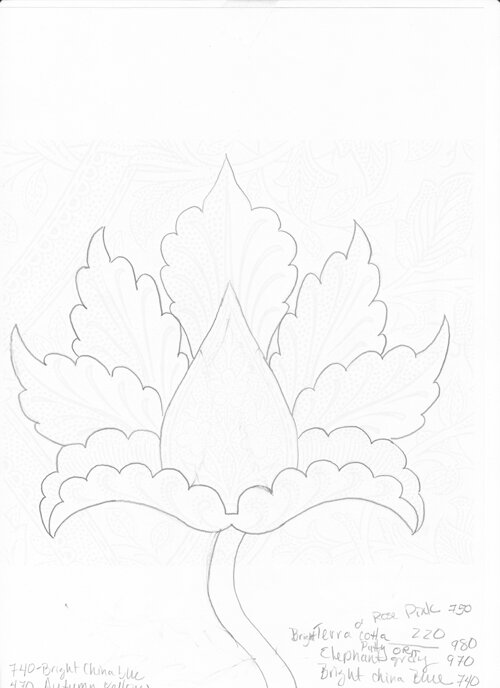 As I drew my own design and worked on the Morris design on the computer, it occurred to me that my drawing skill isn't excellent but it's OK. What I lack is a steady hand and the ability to draw something symmetrically. I've tried using glasses, coins, the edge of a pan lid...just about anything I can lay my hands on to help me make smoother, more pleasing lines. No luck so far. Then I discovered French curves! I know, they sound like something one should find in a fancy lingerie shop but they aren't. French curves are drafting or drawing tools used by designers who need to make those lovely swooshing curves we see so often. Think of the shape of a beautiful sports car and you'll have the idea.
As I drew my own design and worked on the Morris design on the computer, it occurred to me that my drawing skill isn't excellent but it's OK. What I lack is a steady hand and the ability to draw something symmetrically. I've tried using glasses, coins, the edge of a pan lid...just about anything I can lay my hands on to help me make smoother, more pleasing lines. No luck so far. Then I discovered French curves! I know, they sound like something one should find in a fancy lingerie shop but they aren't. French curves are drafting or drawing tools used by designers who need to make those lovely swooshing curves we see so often. Think of the shape of a beautiful sports car and you'll have the idea.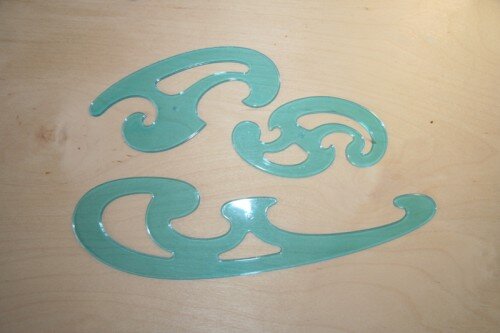 I ordered a set of three from Amazon and they arrived yesterday. I can't wait to try them and see what kind of design I can come up with on my own. Hopefully I may now be able to produce what's in my mind's eye.What about you? What are your tricks for drawing what you imagine? Are you super talented with a pencil and a needle? Or are you like me and need a little assistance? Can you use a computer to do your drawings (if so I am in awe of you!).
I ordered a set of three from Amazon and they arrived yesterday. I can't wait to try them and see what kind of design I can come up with on my own. Hopefully I may now be able to produce what's in my mind's eye.What about you? What are your tricks for drawing what you imagine? Are you super talented with a pencil and a needle? Or are you like me and need a little assistance? Can you use a computer to do your drawings (if so I am in awe of you!).
